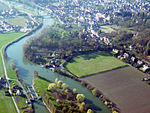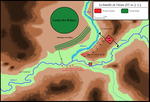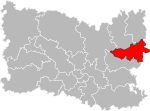Battle of Compiègne
The Battle of Compiègne was fought on 26 September 715 and was the first definite battle of the civil war which followed the death of Pepin of Heristal, Duke of the Franks, on 16 December 714. Dagobert III had appointed one Ragenfrid as mayor of the palace in opposition to Pepin's choice as his successor: his grandson Theudoald. Ragenfrid engaged in battle with Theudoald, then young, and defeated him, sending him fleeing back to his grandmother Plectrude in Cologne. According to the Liber Historiae Francorum, Theudoald lost his "innocent life" soon after, but other sources indicate him surviving for many years. Whatever the case, Charles Martel, Pepin's illegitimate son, soon escaped Plectrude's prison and Dagobert III soon died. The new king, Chilperic II, reappointed Ragenfrid, whose power was affirmed by the people of Neustria while the magnates of Austrasia elected Charles mayor. Plectrude remained holed up in Cologne, still with some supporters in Austrasia, and the war became a three-way conflict. As soon as Charles Martel gathered his supporters and trained them, he triumphed over all comers.
Excerpt from the Wikipedia article Battle of Compiègne (License: CC BY-SA 3.0, Authors).Battle of Compiègne
Carrefour de la Faisanderie, Compiègne
Geographical coordinates (GPS) Address Nearby Places Show on map
Geographical coordinates (GPS)
| Latitude | Longitude |
|---|---|
| N 49.39796 ° | E 2.87301 ° |
Address
Carrefour de la Faisanderie
Carrefour de la Faisanderie
60200 Compiègne
Hauts-de-France, France
Open on Google Maps










